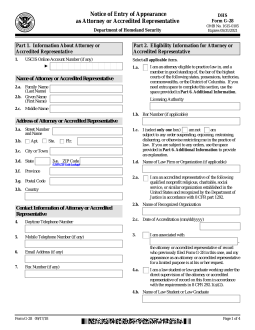Updated December 27, 2023
A Form G-28 (Notice of Entry of Appearance as Attorney or Accredited Representative) establishes that an attorney or other type of representative is helping another person prepare immigration forms. Form G-28 is commonly provided together with other immigration forms, such as a work permit application, filed on another’s behalf, and can let government agencies like the U.S. Citizenship and Immigration Services (USCIS) know that the representative will be assisting in the future.
Preparer vs. Interpreter
Some immigration forms will ask whether the form was filled out with the assistance of an interpreter and separately ask whether someone else “prepared” the form on the applicant’s behalf. A G-28 is for those who prepare documents and is not required for someone who provides only translation services, but some immigration forms will ask for an interpreter’s contact information and/or signature.
Table of Contents |
What is a G-28?
A G-28 is called a “Notice of Entry of Appearance.” It’s a form that lets the various entities that handle immigration-related matters know that a person is assisting in immigration matters. Many immigration matters will require several rounds of responses sent back and forth between the relevant agency and a preparer, and a G-28 can help ensure that the forms can be sent directly to the representative.
In the United States, immigration law is among the most complicated areas of law, and many people working through the system hope to attain assistance from an attorney. But although the stakes of immigration matters are often high, unlike with criminal cases, the government is not obligated to provide people in immigration cases with an attorney.[1]
When is Form G-28 Required?
A G-28 is required whenever an attorney, accredited representative or other party helps someone prepare a document in an immigration matter.[2] A G-28 is usually filed concurrently with the first form that the preparer works on.
Once a G-28 has been filed, it is not required to file a new one with each document filed. However, if a preparer is helping someone seeking an immigration benefit through a “derivative” status, such as the spouse of a person applying to change their immigration status, then a G-28 is required for each client assisted.
Additionally, if an authorized person is assisting a preparer who already has a G-28 for represenatation of a client by helping prepare an individual document for that client, an additional G-28 is required.
Filing an Additional G-28
There are some instances in which, even if a preparer has already filed a G-28 on behalf of work done for an individual client, it may be necessary to file an additional one. This happens when a preparer is filing forms with multiple immigration agencies on a single client’s behalf.
The Department of Homeland Security (DHS) is the federal department that oversees immigration matters, but it contains many smaller agencies within it, including:[3]
- Citizenship and Immigration Services (USCIS): Handles applications for immigration and naturalization benefits
- Customs and Border Protection (CBP): Enforces immigration laws at and around ports of entry
- Immigration and Customs Enforcement (ICE): Responsible for detention and removal actions
Part 3 of a G-28 asks which of these agencies the preparer’s “appearance” is related to. If a preparer has already filed a G-28 on behalf of a client for a matter overseen by one of these agencies — for example, contesting deportation with ICE — and then wants to help the client with a different matter, such as applying for a work permit with USCIS, then an additional G-28 is necessary.
Who Can File a G-28?
There are two different categories of preparers or representatives who may file a G-28: attorneys and accredited representatives. There are other types of people who may assist with the preparation of immigration documents, but they may not file a G-28.
Attorneys
Immigration matters have their own trial court and preliminary appeal system that is overseen by the Office of the Attorney General. Hence, an attorney who is eligible to practice law in any state can file a G-28.[4]
For particularly complex or demanding cases, an attorney may be the best option. But there are many other actions in the immigration system in which someone other than an attorney may be able to provide assistance.
Accredited Representatives
An accredited representative is someone whom the Executive Office of Immigration Review (EOIR) has authorized to represent clients in immigration matters on behalf of a recognized organization. People seeking help with immigration matters are common targets for fraudsters, and those considering hiring an accredited representative should consult the Department of Justice’s state-by-state list before signing an agreement.
Once they register with the EOIR, fully accredited representatives can do many of the same things as lawyers, including practicing before the immigration courts and the Board of Immigration Appeals.[5]
Preparers Who Cannot File a G-28
Law students and law school graduates who are not yet admitted to the bar of a state can assist in immigration matters, but cannot file a G-28. Both law students and graduates must work under the supervision of a licensed attorney or recognized accredited representative.
When a student or graduate is preparing immigration forms, the supervising attorney or representative must submit a G-28, or have already submitted one, and both the supervisor and the student/graduate should sign. Law students and law school graduates cannot accept compensation for assisting with immigration matters. In the case of a student, the work must occur under the auspices of a law school clinic or legal aid program.[6]
People who are neither attorneys, accredited representatives, nor law students may assist in immigration matters as “respectable individuals,” but must obtain permission from the Department of Homeland Security. Attorneys who are licensed to practice law in a country other than the United States should submit Form G-28I.
How to File (3 Steps)
1. Sign Representation Agreement

Before filling out any forms, including a G-28, a preparer and the person seeking assistance should sign their own representation agreement. This is a contract containing at least the following terms:
- The identity and contact information for the client and the preparer
- The scope of services that the client is seeking
- An overview of expectations for the preparer
- An explanation that information provided by the client will remain confidential
- For law firms or accredited organizations, a proviso that the preparer may share client information with others within the firm or organization, who are also bound to keep it confidential
It is not necessary to submit a representation agreement when filing a G-28, but providing services on immigration matters without one can lead to confusion for both parties, and undermine the protections help from a preparer is intended to provide.
2. Fill Out the Form

Once there is a signed representation agreement, the preparer may begin filling out the G-28. This may be done concurrently with another form that the client is seeking assistance with, and many immigration forms will ask whether a G-28 is attached or included with the submission.
The preparer should fill out the G-28 with the client present or monitoring via videoconference, and with the assistance of an interpreter if necessary. Part 4, the section for the client’s consent, is particularly important. Preparers should discuss with the client whether responses from USCIS or other agencies should be sent to the preparer or the client, and indicate as such in this section.
3. File Documents

Once the G-28 has been filled out and signed, it is ready to be submitted. The G-28 should be sent to the same address as the other form the preparer filled out on the client’s behalf.
If a preparer has already filed a G-28 on behalf of the client, and another preparer who is associated with the original is assisting by preparing an individual form, the assisting preparer must file their G-28 in person at a DHS office:
- CPB Field Offices
- ICE Field Offices
- USCIS Field Offices (appointment required)


